Key takeaways:
- Community dialogues create safe spaces for sharing diverse perspectives, fostering empathy and understanding through personal storytelling.
- Engaging participants through active listening and open-ended questions encourages deeper connections and discussions.
- Overcoming challenges in dialogues requires intentional facilitation, addressing power dynamics, and building trust among participants.
- Facilitators benefit from vulnerability and flexibility, as sharing personal experiences can encourage openness and meaningful engagement.
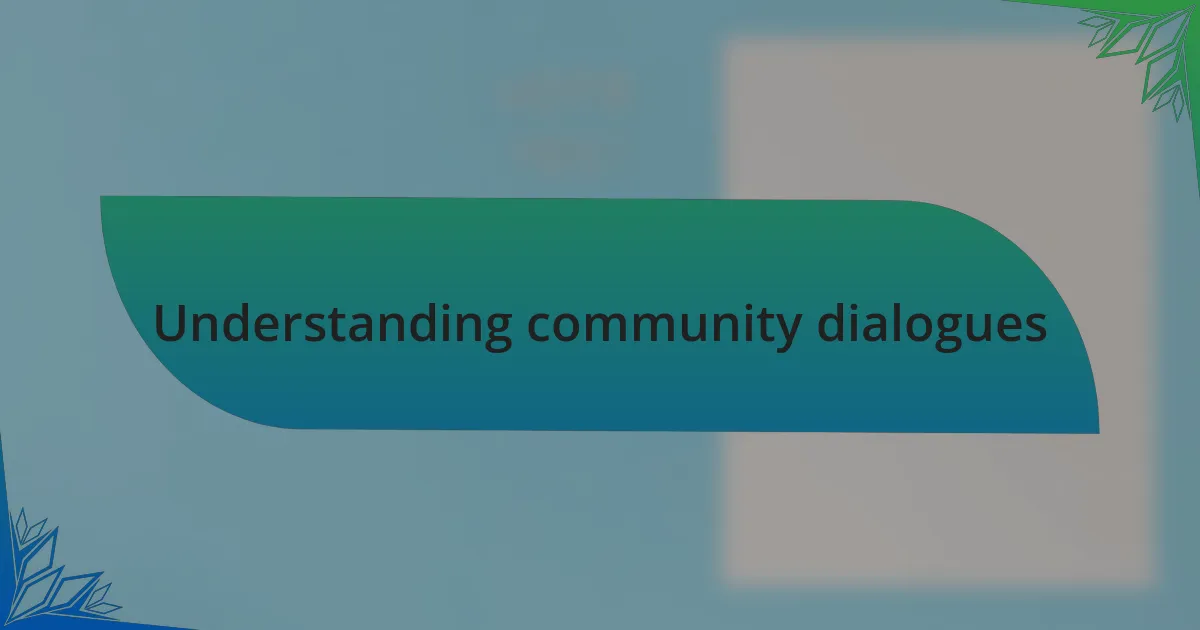
Understanding community dialogues
Community dialogues serve as a vital platform for individuals to share diverse perspectives and foster understanding. I remember my first experience facilitating such a dialogue; it was both exhilarating and daunting. Witnessing participants, who initially seemed entrenched in their views, slowly begin to listen and build empathy was incredibly rewarding.
These dialogues often illuminate shared values, even among those with conflicting opinions. I once facilitated a session where a heated debate transformed into a heartfelt conversation when a participant shared a personal story about their struggles. It made me realize how crucial storytelling is in bridging gaps; it compels us to reflect: what experiences shape our beliefs?
Ultimately, understanding community dialogues is about creating safe spaces for authentic engagement. I continually ask myself, how can we cultivate these environments where everyone feels valued? The answer lies in intentional facilitation, active listening, and mutual respect, allowing voices to flourish and connections to deepen.
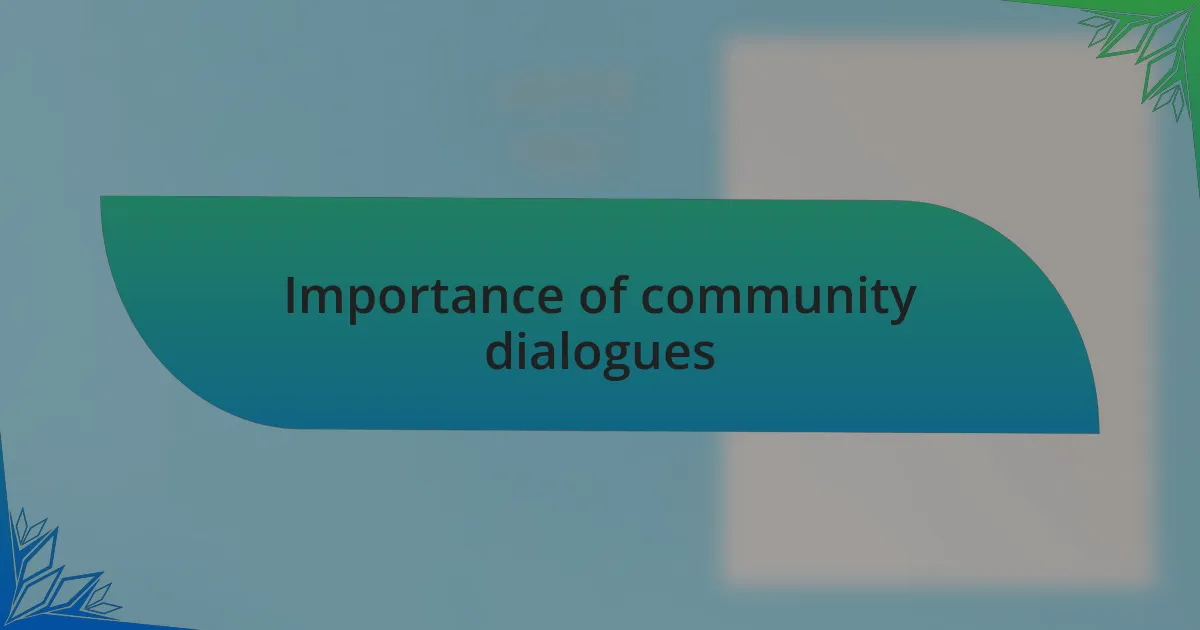
Importance of community dialogues
Engaging in community dialogues holds immense importance as they provide an avenue for participants to express their thoughts and feelings openly. I remember one particular session where a young activist confronted older community members about their apathy. The sparks flew initially, but that raw emotion transformed into a constructive exchange, revealing how generational differences shape our perceptions. The dialogue illustrated the power of sharing not just ideas, but emotions that drive our convictions.
These conversations are not merely about exchanging viewpoints; they foster meaningful relationships among community members. During one event, I witnessed a retired veteran and a local youth bond over their shared love for their neighborhood. It was touching to see how such connections can promote collaboration, bridging divides that often seem insurmountable. Isn’t it fascinating how simply sitting down together can plant the seeds for future cooperation?
Moreover, community dialogues serve as a barometer for societal health, reflecting underlying issues that need to be addressed. I often think about how the frank conversations we have can lead to actionable change. For instance, a discussion on affordable housing sparked a movement that united various local organizations. Such moments make me ponder: what does it take for a community to mobilize? In my experience, it starts with the courage to speak and the willingness to listen.
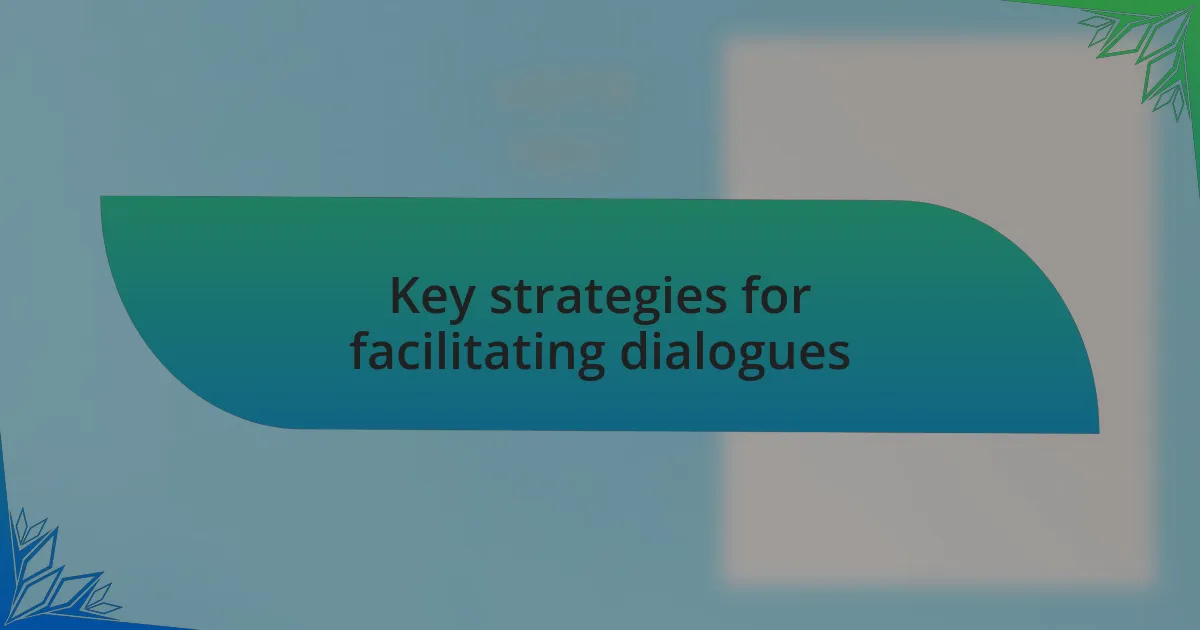
Key strategies for facilitating dialogues
Creating a safe environment is one of the most critical strategies for effective dialogue. I once facilitated a session where participants shared personal stories about their political views, and I realized that setting ground rules on respect and confidentiality was essential. It not only helped in easing tensions but also fostered a sense of trust. Have you ever noticed how openness blooms when people feel safe to express themselves?
Active listening is another vital strategy that cannot be overlooked. In one memorable discussion, I observed how a simple nod or a thoughtful pause encouraged speakers to delve deeper into their experiences. I found that when participants felt truly heard, they were more willing to engage and reflect on differing perspectives. Isn’t it remarkable how just being attentive can transform a conversation?
Lastly, using open-ended questions can fuel deeper engagement. During a dialogue on social justice issues, I posed a question about personal experiences related to inequality. The responses were not only heartfelt but also sparked lengthy discussions that many participants hadn’t anticipated. Reflecting on this, I can’t help but wonder: aren’t the best conversations born from questions that invite exploration rather than those that demand answers?
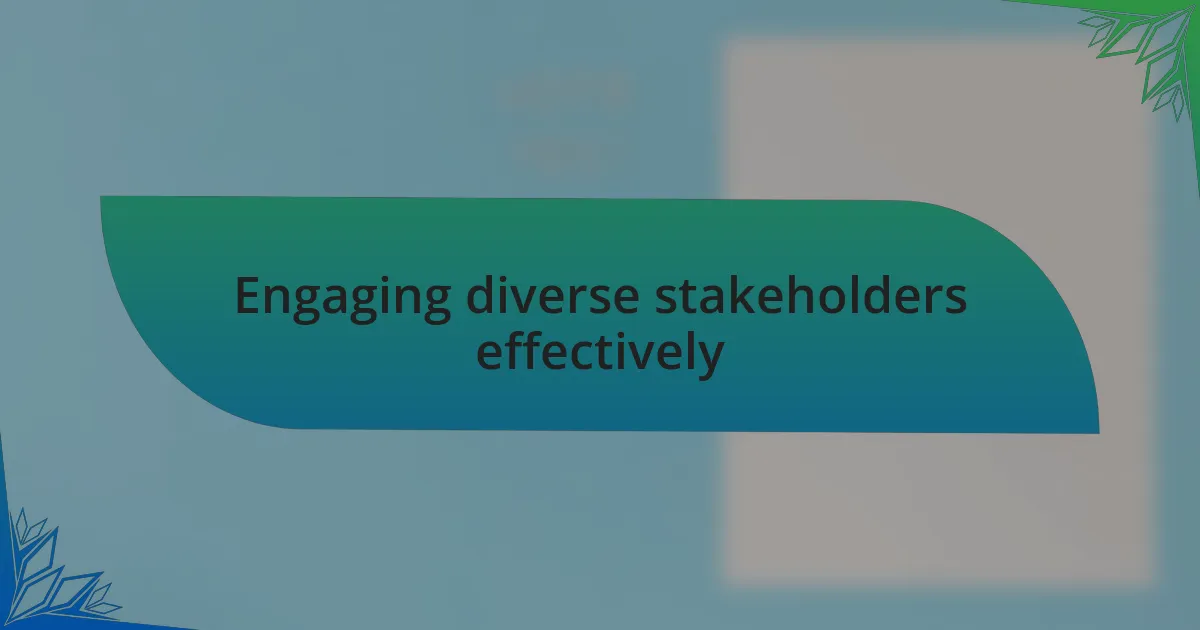
Engaging diverse stakeholders effectively
Engaging diverse stakeholders means recognizing and appreciating the unique narratives each individual brings to the table. I remember a workshop where participants represented various community groups, and I made it a point to acknowledge their backgrounds and experiences upfront. This simple act of recognition transformed the atmosphere; suddenly, everyone was more open to dialogue. Have you ever noticed how validating someone’s story can bridge even the widest gaps?
To connect effectively, I’ve found it crucial to tailor our approaches to suit different stakeholders. In one instance, while working with youth activists and seasoned community leaders, I employed different discussion formats that appealed to both parties. It was fascinating to see how an interactive activity compelled the youth to share their insights, leading the leaders to reflect on their traditional methods. Doesn’t it make sense to adapt our communication styles to reach everyone?
Emotional resonance is another vital tool in fostering effective engagement. I once shared a heartfelt anecdote about a local issue that impacted my neighborhood, deeply moving the room. The power of vulnerability in dialogue cannot be overstated; it invites others to connect on a human level. Don’t you think that when people share their emotions, they create a collective space for understanding?
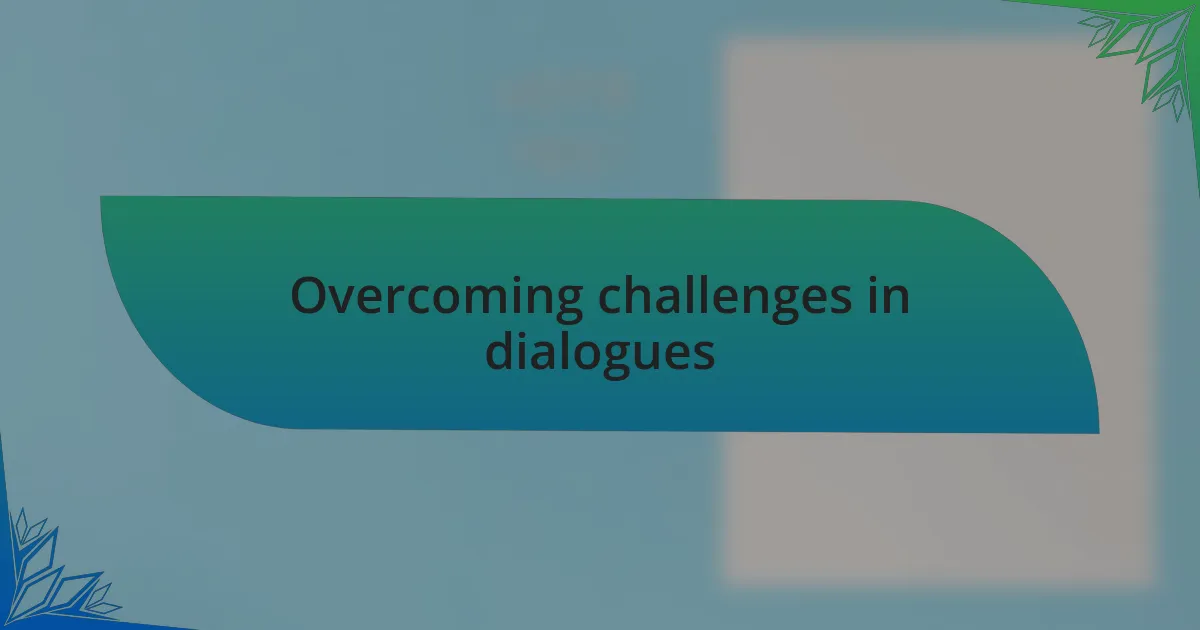
Overcoming challenges in dialogues
Navigating challenges in community dialogues often requires us to confront uncomfortable realities. I recall a particularly tense session where differing political beliefs clashed audibly. Instead of allowing emotions to boil over, I facilitated a moment of silence and invited participants to express their frustrations one at a time. This approach not only defused the tension but also highlighted the importance of active listening. Have you ever seen how taking a step back can change the dynamic completely?
Another hurdle I faced was the tendency for some voices to dominate discussions. During one memorable dialogue, I noticed a few participants were consistently overshadowing quieter members. To address this, I implemented a ‘talking stick’ method, encouraging a more equitable exchange. It was rewarding to witness the quieter voices emerging and sharing profound insights. Isn’t it amazing how sometimes we just need to create space for every voice to be heard?
Building trust among participants is paramount in overcoming dialogue challenges. I ventured into a community where skepticism was high due to past miscommunications. By starting with small group discussions and sharing personal anecdotes about my own missteps in communication, I found common ground. It was remarkable to see how vulnerability fostered trust and encouraged more open sharing. How much stronger do you think our dialogues become when we lead with authenticity?
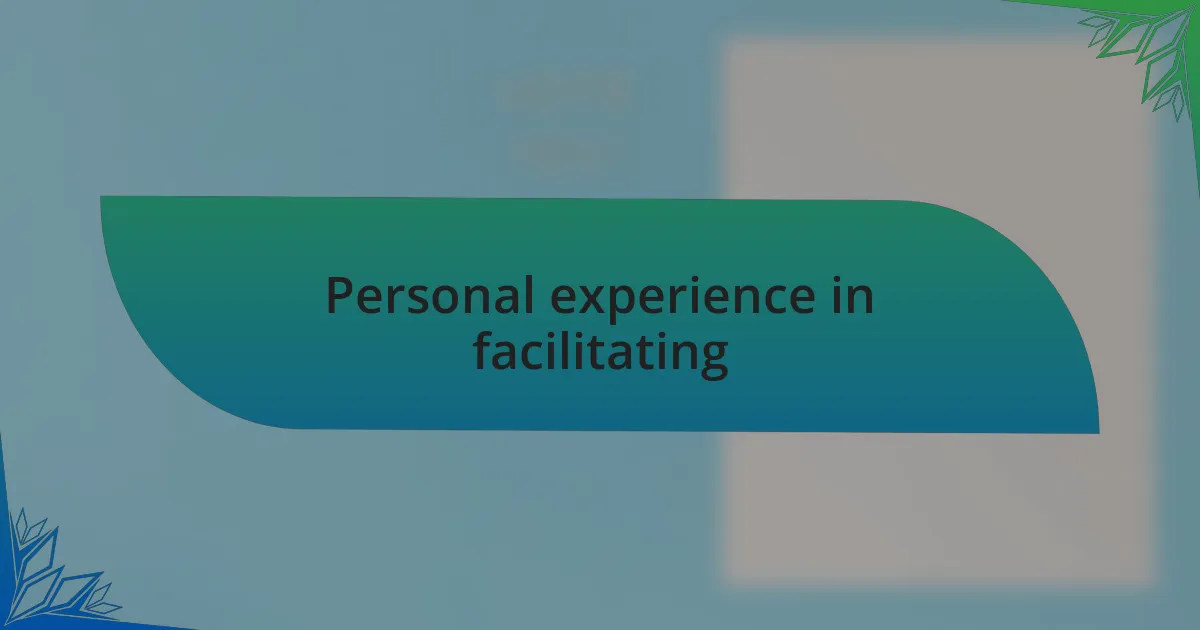
Personal experience in facilitating
Facilitating community dialogues has truly shaped my understanding of collective engagement. I remember one evening spent in a local community center where emotions were running high. Participants expressed deep frustrations about local policies, and I felt compelled to share my own experiences with similar frustrations. This personal touch seemed to break the barrier, allowing others to open up. Isn’t it curious how vulnerability can dissolve walls?
On another occasion, I organized a dialogue in a neighborhood that had experienced significant division over a recent election. I approached the event with the intention to listen first. As I shared stories of my own electoral frustrations and hopes, I noticed the participants began to mirror that openness. It was exhilarating to see them connect over shared experiences rather than the divisive rhetoric that usually clouded our discussions. How often do we miss the opportunity to bond over similar struggles?
One of my biggest learning moments came when a participant challenged my methods. Initially, I felt defensive, but I took a breath and asked for their perspective. This pivot turned the conversation into a collaborative exploration rather than an adversarial debate. It reminded me how essential it is to remain flexible and embrace different viewpoints. Have you found that embracing criticism can sometimes lead to unexpected breakthroughs?
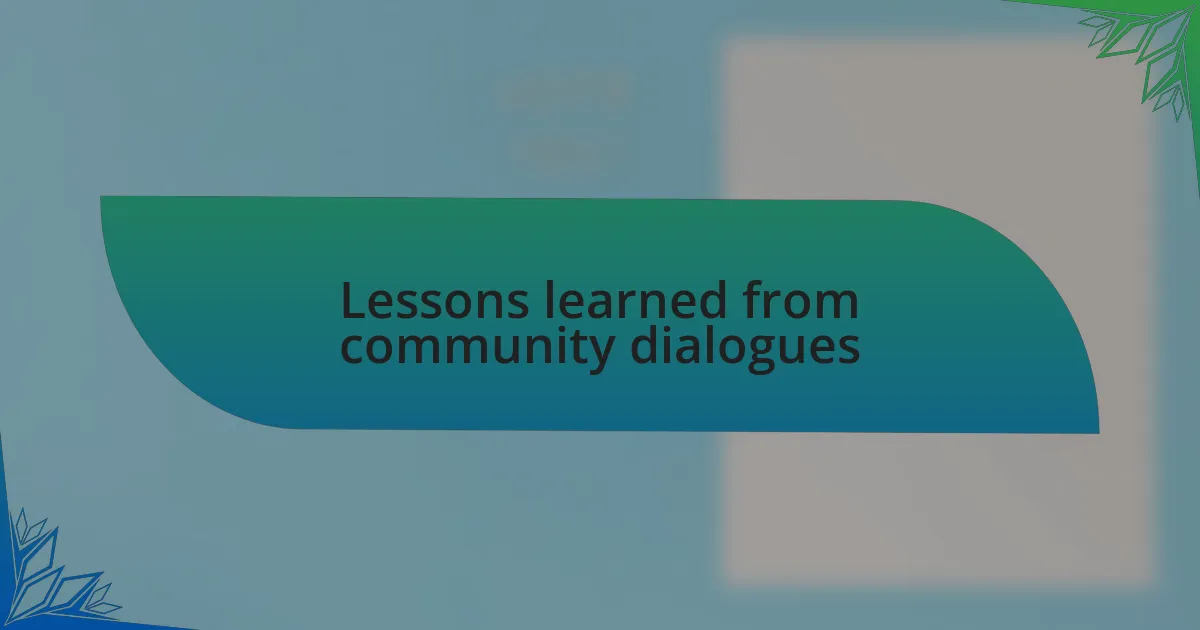
Lessons learned from community dialogues
Engaging in community dialogues taught me the stark difference between listening and hearing. During one session, I recalled being so eager to respond that I missed key sentiments being expressed. It struck me then how crucial it is to truly absorb words and emotions, rather than simply preparing a rebuttal. Have you ever found yourself more focused on what you want to say rather than getting the full picture of someone else’s feelings?
Another lesson emerged when dealing with conflicting perspectives. In one event, two participants had polar opposite views on a community initiative. Instead of allowing the discussion to spiral into confrontation, I encouraged them to articulate their underlying motivations. This exercise transformed their frustration into empathy; they began to see each other as individuals rather than opposing forces. Doesn’t it make you wonder how often we forget the human stories behind differing opinions?
I also discovered the importance of establishing a safe space. At one dialogue, participants were hesitant to share, and I realized that my introduction hadn’t emphasized confidentiality. Once I addressed this, the atmosphere shifted dramatically. This moment reminded me that without trust, honest conversations are nearly impossible. Have you ever noticed how a simple acknowledgment of a safe environment fosters openness?